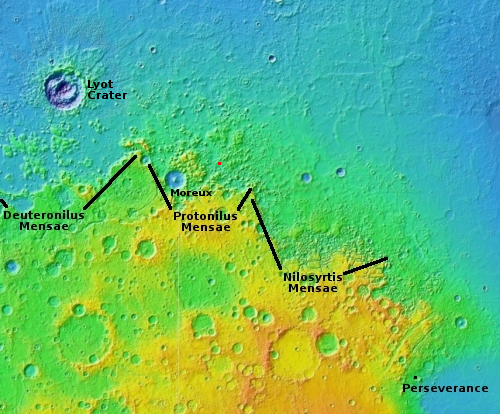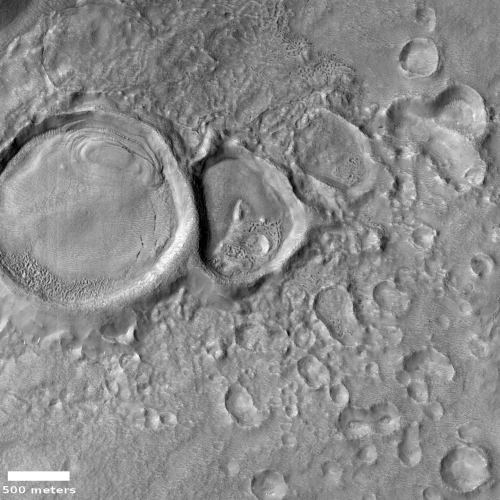Deformed Martian craters
Cool image time! The picture to the right, rotated, cropped, and reduced to post here, was taken on September 3, 2021 by the high resolution camera on Mars Reconnaissance Orbiter (MRO). The focus of the image for the MRO science team were the wedding cake layers inside the largest crater. These layers suggest glacial ice, with the layers suggesting multiple cycles of glacial ebb and flow. Since the crater is at 43 degrees north latitude, and sits in the chaos region dubbed Protonilus Mensae, smack dab in the center of what I call Mars’ glacier country, this conclusion makes perfect sense.
To my eye, however, the most interesting feature of this photo are the many distorted craters. The overview map below shows the picture’s location, as well as several nearby very large impact craters which might have caused many secondary impacts, including the many craters at this location.

The red dot marks the location of today’s cool image. The three mensae regions cover most of Mars’ northern glacier country.
Why are the craters distorted? Research has shown that even at impact they would have been circular, even if the impact has been an oblique one.
My guess is that the solution lies underground, which at this location probably has a somewhat thick near-surface ice layer. When the impact occurred, much of the ejecta that formed the crater rim’s was probably frozen ice. The heat of impact would have vaporized a great deal of that ice, but enough would have simply melted and then quickly refroze. In that melt-freeze process it is very likely that the crater rims would have ended up distorted.
Furthermore, later impacts on top of older craters would have distorted those older craters further, as it appears happened to the craters to the east of the largest. In the overview map the large craters to the west, 147-mile wide Lyot Crater and 86-mile-wide Moreux Crater, would have produced many secondaries at two different times, thus resulting in the overlay and melted effect seen here.
On Christmas Eve 1968 three Americans became the first humans to visit another world. What they did to celebrate was unexpected and profound, and will be remembered throughout all human history. Genesis: the Story of Apollo 8, Robert Zimmerman's classic history of humanity's first journey to another world, tells that story, and it is now available as both an ebook and an audiobook, both with a foreword by Valerie Anders and a new introduction by Robert Zimmerman.
The print edition can be purchased at Amazon or from any other book seller. If you want an autographed copy the price is $60 for the hardback and $45 for the paperback, plus $8 shipping for each. Go here for purchasing details. The ebook is available everywhere for $5.99 (before discount) at amazon, or direct from my ebook publisher, ebookit. If you buy it from ebookit you don't support the big tech companies and the author gets a bigger cut much sooner.
The audiobook is also available at all these vendors, and is also free with a 30-day trial membership to Audible.
"Not simply about one mission, [Genesis] is also the history of America's quest for the moon... Zimmerman has done a masterful job of tying disparate events together into a solid account of one of America's greatest human triumphs."--San Antonio Express-News
Cool image time! The picture to the right, rotated, cropped, and reduced to post here, was taken on September 3, 2021 by the high resolution camera on Mars Reconnaissance Orbiter (MRO). The focus of the image for the MRO science team were the wedding cake layers inside the largest crater. These layers suggest glacial ice, with the layers suggesting multiple cycles of glacial ebb and flow. Since the crater is at 43 degrees north latitude, and sits in the chaos region dubbed Protonilus Mensae, smack dab in the center of what I call Mars’ glacier country, this conclusion makes perfect sense.
To my eye, however, the most interesting feature of this photo are the many distorted craters. The overview map below shows the picture’s location, as well as several nearby very large impact craters which might have caused many secondary impacts, including the many craters at this location.

The red dot marks the location of today’s cool image. The three mensae regions cover most of Mars’ northern glacier country.
Why are the craters distorted? Research has shown that even at impact they would have been circular, even if the impact has been an oblique one.
My guess is that the solution lies underground, which at this location probably has a somewhat thick near-surface ice layer. When the impact occurred, much of the ejecta that formed the crater rim’s was probably frozen ice. The heat of impact would have vaporized a great deal of that ice, but enough would have simply melted and then quickly refroze. In that melt-freeze process it is very likely that the crater rims would have ended up distorted.
Furthermore, later impacts on top of older craters would have distorted those older craters further, as it appears happened to the craters to the east of the largest. In the overview map the large craters to the west, 147-mile wide Lyot Crater and 86-mile-wide Moreux Crater, would have produced many secondaries at two different times, thus resulting in the overlay and melted effect seen here.
On Christmas Eve 1968 three Americans became the first humans to visit another world. What they did to celebrate was unexpected and profound, and will be remembered throughout all human history. Genesis: the Story of Apollo 8, Robert Zimmerman's classic history of humanity's first journey to another world, tells that story, and it is now available as both an ebook and an audiobook, both with a foreword by Valerie Anders and a new introduction by Robert Zimmerman.
The print edition can be purchased at Amazon or from any other book seller. If you want an autographed copy the price is $60 for the hardback and $45 for the paperback, plus $8 shipping for each. Go here for purchasing details. The ebook is available everywhere for $5.99 (before discount) at amazon, or direct from my ebook publisher, ebookit. If you buy it from ebookit you don't support the big tech companies and the author gets a bigger cut much sooner.
The audiobook is also available at all these vendors, and is also free with a 30-day trial membership to Audible.
"Not simply about one mission, [Genesis] is also the history of America's quest for the moon... Zimmerman has done a masterful job of tying disparate events together into a solid account of one of America's greatest human triumphs."--San Antonio Express-News



Nothing constructive to add, just wanted to say that I love these pictures – so different from Lunar craters.